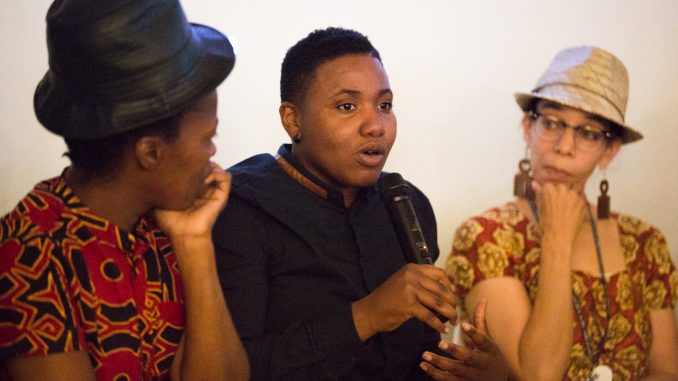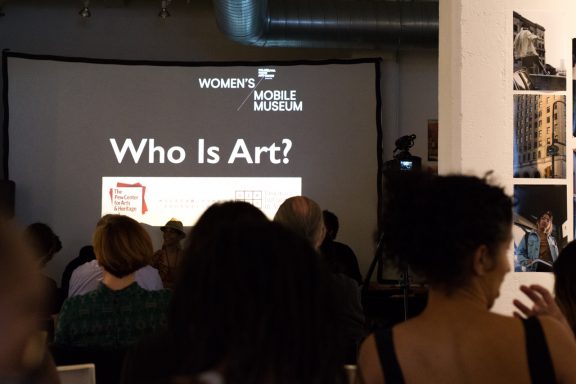
When Davelle Barnes mentioned she wanted to create an art piece featuring images of popular American iconography like the flag and rifles, renowned South African photographer and visual activist Zanele Muholi questioned her.
“Is this safe for you?”
Barnes, who began studying film at Temple in 2015, said she’s never been asked that before.
“People love when artists cover bold topics, but rarely stop to consider how it might make you, the artist, feel,” the poet, filmmaker and military veteran who served in Afghanistan, Kuwait and Jordan said. “If you’d be comfortable or if you’d be putting yourself in danger.”
Caring for each others’ well-being is a crucial part of the bond the 10 artists in the Women’s Mobile Museum have formed since beginning to work together in February. The artists are part of a year-long apprenticeship program at the Philadelphia Photo Arts Center that provides learning opportunities for women interested in media arts.
The program combats the challenges economically-disadvantaged women experience in art spaces. These include lack of artistic resources and opportunities to showcase their work and little or no access to higher education and professional training.
Barnes withdrew from Temple when she started experiencing homelessness and her mental health suffered. She often explores war, race and homophobia in her work. Barnes who hopes to return to Temple within the next two semesters.
“Some people, white people, listen to me because I have fought for this country in a specific way,” Barnes said. “With that privilege, I have to share my views and experience in this country with them.”
Under Muholi’s leadership, the artists – all self-taught with backgrounds in a variety of media, including poetry, painting and film – are using photography to explore one central question: Who is art for?
“We’re addressing the issue of accessibility and who gets to see art by creating the museum as a mobile unit,” Muholi said. “We want people in the neighborhoods around us to have access to art and be able to enjoy it.”
The Women’s Mobile Museum will open in September for three weeks at Juniata Park in Northwest Philadelphia. It will then move to Dixon House in Point Breeze before stopping at the Pennsylvania Academy of the Fine Arts. The project will end with a culminating exhibit at the Philadelphia Photo Arts Center from January 10 to March 30, 2019.
In addition to providing each artist with a camera and access to art equipment and studio spaces, PPAC developed a calendar of education and community work for the collective. The events include artist talks, trips to museums and galleries and training in writing, graphic design, video production and public speaking.
Muholi, Barnes and two other artists in the program, Andrea Walls and Afaq Mahmoud, participated in a panel discussion at the PPAC on May 24. Moderated by Dejay Duckett, the director of curatorial services at the African American Museum in Philadelphia, the panel introduced the project and its artists to the public.

In Walls’ project, she’s interested in “capturing women who are actively in defiance of some status quo.” The 1989 English alumna plans to contact Ramona Africa, the political activist and last remaining survivor of the 1985 MOVE bombing in Philadelphia. Walls grew up a few blocks away from the site of the bombing and explores the incident in her poetry book “Ultraviolet Catastrophe.”
She also plans to photograph the three immigrant women organizers recently fired from immigrant justice movement the New Sanctuary Movement of Philadelphia.
Walls said she is determined to help shake the status quo, but is also enthusiastic about the effects that doing so has on the larger community.
“Art is for people who need a witness because their own testimony of who they are is not enough,” Walls added. “It’s for everybody who needs evidence that they are here and that they exist.”
For Barnes, she hopes the museum leaves people feeling seen and empowered, particularly children who can start thinking of art as an attainable and valid career option. She added transportation to and from art spaces can be challenging for people who don’t have money or access to transportation.
“By bringing the exhibit into community spaces, we hope people in the communities feel like art is for them,” Barnes said.
Dr. Kathleen Walls, a 1993 early childhood and education alumna, serves as an advisor to the collective. She said she doesn’t have to remind the artists why the program and their participation is critical – they already know.
“There are so many people who don’t see themselves represented, so it starts to create an illusion that they’re not worthy or that they can’t be a part of this art world,” Walls said.
“These 10 women have become the representation that the world needs.”










Be the first to comment